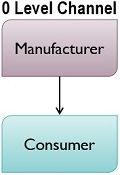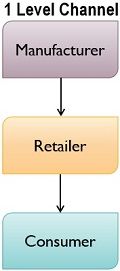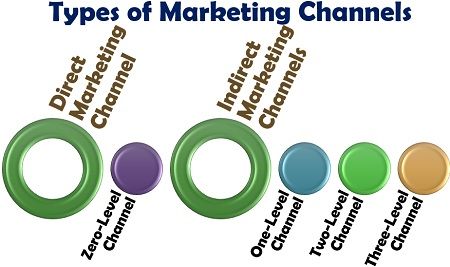Definition: Marketing channel refers to the means through which the physical distribution of goods takes place from the manufacturer to the customers, either directly or through intermediaries. The manufacturer can also adopt Multi-Channel marketing if he finds it suitable for his product and the business.
In simple words, marketing channels are a medium to facilitate the active physical exchange of goods or services.
Content: Types of Marketing Channels
- Various Channels of Distribution
- Key Terminology
- Direct Marketing Channel
- Indirect Marketing Channels
- Conclusion
Various Channels of Distribution
The different types of marketing channels or channels of distribution have been identified based on the number of intermediaries or the levels the goods or services passes through to reach the customers.
These marketing channels are bifurcated into the following two categories:
Direct Marketing Channel
Direct selling is that medium of distribution in which there is no middle person involved, and the manufacturer directly sells the goods or services to the customer. It is also termed as ‘zero-level channel’.
 This type of channel is popular among the services industry. Most of the services like travel, catering, salons fall under the direct marketing channel.
This type of channel is popular among the services industry. Most of the services like travel, catering, salons fall under the direct marketing channel.
Even when the products are complicated to use like the industrial machinery require direct selling and support from the manufacturer.
The small manufacturer of general goods finds this channel more profitable and cost-efficient since they cannot afford giving margin to the intermediaries.
For Example; In restaurants, the food is prepared as well as served to the consumers.
Indirect Marketing Channels
In this channel of distribution, the goods produced by manufacturing units passes through different intermediaries to reach its final consumer.
The indirect channels can be further classified into the following types, each of which is supported by an example:
One-Level Channel
The single-level channel involves only one middle person, i.e. the retailer who purchases the goods from the manufacturer and sells them to the customers. The shopping malls and marts use this channel for acquiring products at a low price and selling them to customers at a reasonable price. Also, the manufacturers of some specialise products like furniture, clothing, footwear, etc. preferably go for the one-level marketing channel.
The shopping malls and marts use this channel for acquiring products at a low price and selling them to customers at a reasonable price. Also, the manufacturers of some specialise products like furniture, clothing, footwear, etc. preferably go for the one-level marketing channel.
For Example; Big Bazaar is a retail mart which buys the products directly from the manufacturer and makes it available to the consumers.
Two-Level Channel
The wholesaler buys the goods in large quantity from the manufacturers and supplies it to the various retailers in small amounts. The retailers to the customers then sell these goods. This channel is preferred by the manufacturers who want to sell their products to obtain market share. It eliminates the expenses which the manufacturer incurs on the sales force, warehousing of goods and other retail selling practices.
This channel is preferred by the manufacturers who want to sell their products to obtain market share. It eliminates the expenses which the manufacturer incurs on the sales force, warehousing of goods and other retail selling practices.
It also facilitates mass production and a high volume of sales by increasing the scalability of the manufacturers.
For Example; Rice yield by farmers is purchased and stored in bulk quantity by the wholesalers. The retailers then buy the rice in small portion from the wholesaler and sell it to the customers.
Three-Level Channel
The manufacturer appoints agents or gives the goods to agencies which further distribute the products to selective wholesalers in large quantity. The wholesalers then sell the rice to the retailers in smaller amount who finally sell it to the customers. This is one of the most commonly used channels of distribution for confectionery products. It is used by the manufacturers who look forward to capturing a massive market by reaching the consumers scattered over a vast geographical area. For instance; in rural marketing.
This is one of the most commonly used channels of distribution for confectionery products. It is used by the manufacturers who look forward to capturing a massive market by reaching the consumers scattered over a vast geographical area. For instance; in rural marketing.
Even the perishable goods manufactured in large quantity need to be distributed through this medium since the manufacturers cant acquire customers more quickly through any other channel.
For Example; Tata Tea manufactured by the company is sold to the agencies in different regions; these agencies sell it to the wholesalers of their respective areas. The wholesaler further sells it to the retailers from where it reaches the customers.
Key Terminology
- Manufacturer: The company or industry or the production unit where the goods are produced on a small scale or large scale for selling in the market, is known as a manufacturer.
- Customer: The person who intends to buy a product or service and is capable of doing so is termed as a customer.
- Wholesaler: The one who buys goods directly from the manufacturer in large quantity intending to sell it to the retailer, to earn a marginal profit is called a wholesaler.
- Retailer: The person who sells goods in small quantity, directly to the customers at the maximum retail price (MRP) is known as a retailer.
- Agent: The one who distributes goods from the manufacturers to the various wholesalers and earns commission over it is called as an agent.
Conclusion
A marketing channel has to be selected wisely to ensure the proper distribution of goods or services to the customers. Selection of a wrong channel may lead to excessive cost, perishability of products, loss, etc.

pratiksha rana says
outstanding, very very informative, useful study for exam
pratiksha rana says
good